|
Focke-Wulf Fw 190 A-8/R2
Weekend Edition
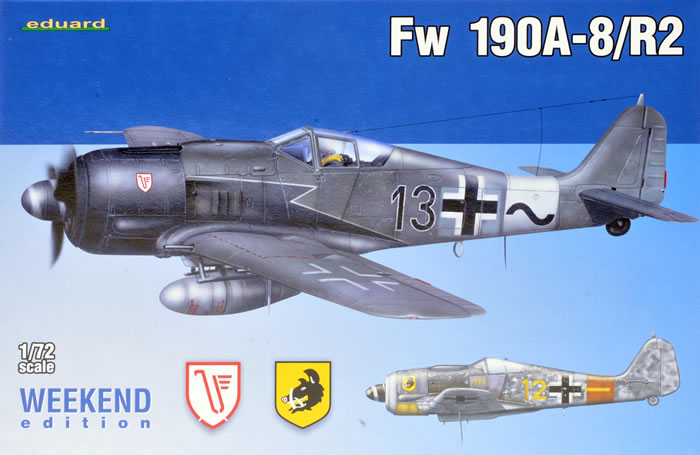
Eduard, 1/72 scale
S u m m a r y : |
Catalogue Number: |
7430 - Fw 190A-8/R-2 Weekend Edition |
Scale: |
1/72 |
Contents & Media |
Eighty-six grey and six clear styrene parts, with decals for two options. |
Price: |
Available on-line from these stockists:
Click for currency conversion. |
Review Type: |
First Look. |
Advantages: |
The best 1/72 Fw 190A-8; very accurate, great detail, and attractively priced. |
Disadvantages: |
None noted. |
Conclusions: |
Eduard’s Fw 190A-8 is the best in 1/72 scale by a long measure. The Weekend Edition is only bettered by the same brand’s Profipack Edition with its colour PE details and paint mask. This is Eduard’s second Fw 190A-8 Weekend Edition, which offers two quite differently configured aircraft to the earlier one.
Not everyone likes PE; and for these people, or those building a closed canopy model where the PE extras will be far less noticeable, the Weekend Edition makes perfect sense and is great value. It is also a great choice for anyone contemplating using the superb Brassin resin cockpit set, because there is little point in paying a premium for the Profipack Edition’s coloured PE if is not to be used.
Hasegawa’s Fw 190 kits were arguably the best in 1/72 scale for the past 24 years. Eduard’s new kits are superb examples of the 1/72 kit maker’s art; only time will tell if they will remain the best until 2039, but they seemingly have every chance of doing so for now.
I cannot recommend this kit highly enough. |
Reviewed by Mark Davies

Eduard’s 1/72 Fw 190A-8/R-2 Weekend Edition is available online from Squadron.com
No Introduction Necessary
The Fw 190 represented a watershed in fighter design; in particular it showed how a radial engine could be installed to rival in-line engine streamlining.
The design was rugged, fast, very manoeuvrable, and had a powerful armament; added to which were good pilot visibility and an ergonomic cockpit layout. It was unmatched as a fighter when first encountered by the RAF in 1941.
Readily adaptable to many roles, it had a wide range of weapon and equipment fits; whilst further development led to in-line engined versions and the Ta 152 series of fighters.
The A-8 was the most produced sub-type of this superlative design.
For those interested, a more detailed account can be found here at Wikipedia.
Previous 1/72-scale Fw 190 A-8 Kits
There have been numerous Fw 190A & F series kits in ‘The One True Scale’ over the years. When looking at variants which correspond to those Eduard is offering we must consider the Fw 190A-5 onwards; so the very nice Fw 190 kits from Tamiya and Zvezda are excluded, being earlier A-3 and A-4 variants.
In my opinion, there are three main rival Fw 190A-8 kits from Airfix, Hasegawa and Revell; although I accept that some would add the simplified assembly kit by Hobby Boss to this list.

Hasegawa’s kits are accurate, have refined surface detail, and are problem free to build; their relative weaknesses are less cockpit and wheel well detail compared to Airfix or Revell, plus their high retail price. Airfix’s kits are essentially accurate, have lots of detail, but have less refined surface detail than Hasegawa; they are slightly more challenging to build than the German or Japanese brands, but represent great value. Revell’s kits are generally accurate, have better detail than Hasegawa, they have nice surface detail but an awful canopy that needs replacing, they also build well and are attractively priced. The choice of best between the three depends on your priorities, but I personally favour Hasegawa overall for its superior and more refined external appearance.
As already mentioned, there are numerous Fw 190 kits beside the three mentioned above, some still being quite worthy if a bit dated. A very handy review of these is available as a free two-part PDF downloadable addendum to Valiant’s Airframe & Miniature No.7 Fw 190; just click here on Part 1 and Part 2 to get the reviews (all scales covered).
Excluding limited availability over-trees, Eduard has released five Fw 190A series boxings since October last year; the A-5 as a Profipack Edition, and the A-8 in Royal Class, Profipack and A-8 Standard wing and A-8/R-2 Weekend Editions. It is the last of these that is the subject of this ‘First Look’.
The Contents
The parts come in a top-opening box and are enclosed in re-sealable cellophane bags, with the clear sprue and decals each in their own separate bags.
Thumbnail panels:1 | 2 | 3 | 4
The instruction booklet is printed in colour on glossy paper, with clear and easy to follow drawings. These can be viewed or downloaded from Eduard’s website by clicking here. Colour call-outs are cross referenced to Gunze Sangyo’s Aqueous and Mr. Color paint ranges, and include RLM codes for the camouflage colours. Quite a few parts are surplus to requirements, as the parts map indicates:
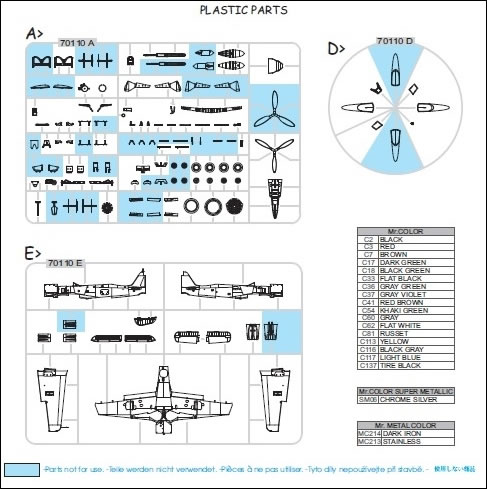
The parts are almost the same as Eduard’s Fw 190A-8 Profipack Edition (reviewed by Glen Porter here on HyperScale in October 2015). Like the Profipack kit, the wings feature the raised upper surface bulges typically associated with the A-8; these could accommodate 30mm MK108 cannons when fitted in place of the standard 20mm MG151’s as the Rustsatze 2 modification.
The kit provides a choice of MG151 for the ‘regular’A-8, or Mk108 cannon barrels for the R-2. It also includes an alternative closed fuselage gun trough section as the pair of MG131’s was not fitted to the machine covered by the R-2 colour scheme (decal option-B)
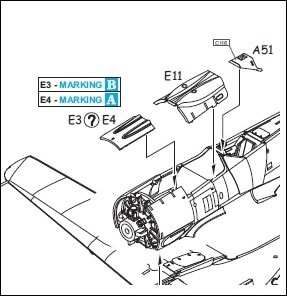
Interestingly, this edition’s other colour scheme (decal option-A) for a ‘regular’A-8 without Rustsatzen, includes armoured glass panels for either side of the sliding canopy hood. These are the same as those associated with Rustsatzen 7 & 8 that also included a considerable amount of additional and internal armour-plate; most notably on the outside surrounding the cockpit along with additional windscreen protection, but this option only has the side glass.
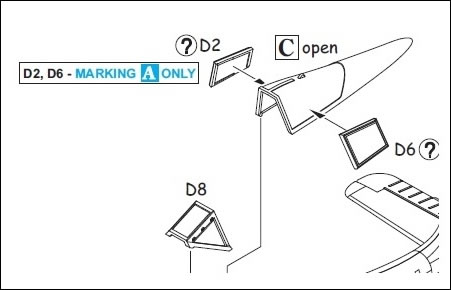
The moulding of the two main grey sprues is flawless, with super-crisp and delicate detail, narrow sprue gates, and thoughtfully positioned ejector pins. The clear parts are likewise flawless, thin and clear.
Just to avoid confusion, I would point out that there is another Fw 190A-8 Weekend Edition #7435 (reviewed by me here on HyperScale). This other kit features what Eduard calls the ‘Standard Wing’ with smooth upper surfaces over the outboard MG151’s. This is essentially the same as an A-7’s wing, although the pitot has been moved outboard on the starboard wing, rather than adjacent to the outer MG151 as on the A-7. For those interested, Issue 66 of Eduard’s product magazine, INFO Eduard, uses drawings to illustrate the various wing styles applicable to Fw 190A-8s from page 22 to 26; click here to open or download the magazine as a PDF.
The Kit
The first thing that struck me was the delectable surface detail this kit exhibits. It has ultra-fine and consistent recessed panel lines, and has the best rivet detail I have encountered in the scale. Rivets have come back into modelling fashion, but unlike many brands following this trend, Eduard has managed to keep theirs unobtrusive and in the right places.
They have also avoided the another flawed practice common to Fw 190 kits, that of moulding the control surfaces with a heavy representation of the underlying framed structure. Instead Eduard’s simulate drum-tight fabric with rib-tapes, as they should.
There is not a lot of room in an Fw 190’s cockpit in this scale, but Eduard has made a nice job of the tub, seat, and control column. The rudder pedals are just the mounts for the PE examples provided with the Profipack Edition, but they will be extremely hard to see any way.
The side console faces with raised details are separate parts that fit to the tub. This allows for different versions, plus there is smooth option to mount coloured PE faces available in the Profipack Edition or separate detail sets. All very thorough! The two-part instrument panel has raised detail and optional instrument decals, and again there are smooth equivalents to accept coloured PE parts. There is a gun-sight molded in clear plastic and separate cockpit coaming.
The cockpit is finished off with a nice a decal harness; which I think is best cut out with backing paper in place to give it a 3D effect and aid realistic positioning (you will need to colour the backing paper to match the harness colours).
If you wish, you can purchase separately either a coloured PE detail set or Brassin resin set to improve on the already good cockpit detail, both of which were reviewed here on HyperScale by Brett Green in December 2015.
The kit includes parts for the common variants of the original flat and blown canopies (there being a rare variation of each as well). The blown canopy was first associated with the FW 190F-8 and ground attack-configured A-8’s, but could be found fitted to almost any Fw 190 version from late 1944.
As mentioned earlier, decal option-A features additional armoured glass panels that must be fixed directly over the sides of the sliding canopy. Considerable is needed to avoid spoiling the clear view through the canopy, so liquid plastic cement should be avoided due to the risk of capillary action drawing the cement between the two panes. Epoxy, watch-makers cement, or PVA come to mind as alternatives.
The canopies are nice and clear with separate windscreen enabling them to be modeled open if wished. It is here we see an example of Eduard’s thoroughness; because the sliding canopy varied in width as it slid open it caused the Perspex hood to flex and subtly change shape, so the kit has open and closed alternatives for each style! There is an armoured headrest and brace to mount inside the canopy, and a decaled stencil warning of the quick release explosive charge to add to the headrest.

The fuselage halves enclose the cockpit tub, firewall and the exhaust ejector stubs that project out of the fuselage side openings. The engine is a more than adequate relief molding with separate reduction gear housing.
Once the fuselage is closed up the panel over the fuselage MG131 guns can be added after inserting the barrel muzzles, along with the upper cowl panel with its two blast troughs. The rudder is provided as a separate item.
The wings are split between their upper and lower surfaces as you would expect. To the lower section is added a wing spar, some structural detail and piping, the inboard MG151 cannons, and wheel well roof. There is a part that fits to the rear of the well roof representing the bottom of the ammunition cans and case ejection chutes for the MG131 cowl guns.
The underside exhausts stubs are provided as an insert in the bottom cowl panel molded with the lower wing, with a separate pipe run for cylinder #8 to fit and exit through its own hole in the panel. The separate ailerons can be attached once the upper wing surfaces are in place.
With the wings attached to the fuselage the combined oil-cooler/cowl lip and its armoured ring can be attached to complete the engine cowl. The prop, its spinner and cooling fan finish off the engine side of things.
The finely moulded tailplanes are two single moldings with integral elevators, the balance horns of which are unattached to the horizontal stabilizer for added realism (the gap is so fine it’s easy to miss without magnification).
There is an ETC-501 centerline pylon (for which blind locating holes in the lower wing need to be opened earlier in construction). This can carry either the drop-tank or bomb supplied with the kit. Alternate mounting racks and sway-braces are supplied for either store.
The undercarriage is very nicely represented with good levels of detail. A choice of treaded or smooth tyres for the main wheel is also provided for. Brett green reported in a build review here on HyperScale that “The landing gear legs are also well detailed, but I found them tricky to position as the main locating hole is quite shallow. Patience and repeated test-fitting is the answer here.”
The pitot comes moulded with the upper side of the starboard wing, so all that is left to mention is a ventral antenna, DF-loop, boarding step, and outboard MG151 barrels.
Given it relative complexity, it seems that the less-detailed Hasegawa kit will probably beat the Eduard kit for ease of assembly. However, Brett Green’s build article mentions the very good fit and general ease of assembly, provided test-fitting is practised. His article included a couple of useful pointers about removing a mounting lug when fitting the upper cowl panel, and spreading the fuselage slightly to meet the wing roots. I would also add to pay careful attention to the instructions, as there are several surplus parts that appear similar to those required; this being the result of mould engineered for multiple versions.
Of course, Eduard specialises in aftermarket details and accessories; and in the case of the Fw 190 these are almost too numerous to mention, but are well worth checking out at Eduard’s website.
Colours & Markings
Two decal options are provided, along with quite extensive stenciling.
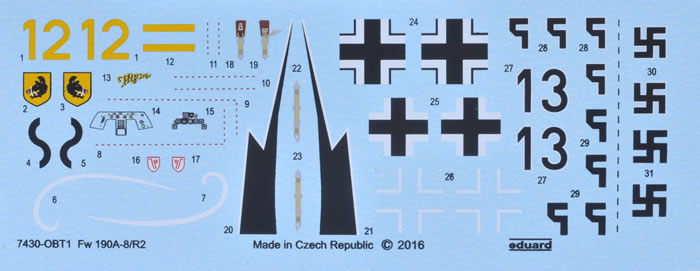
The machines covered are those of:
- Option-A, II (Sturm)/JG 3, “Udet”. Werner Gerth, July 1944; and
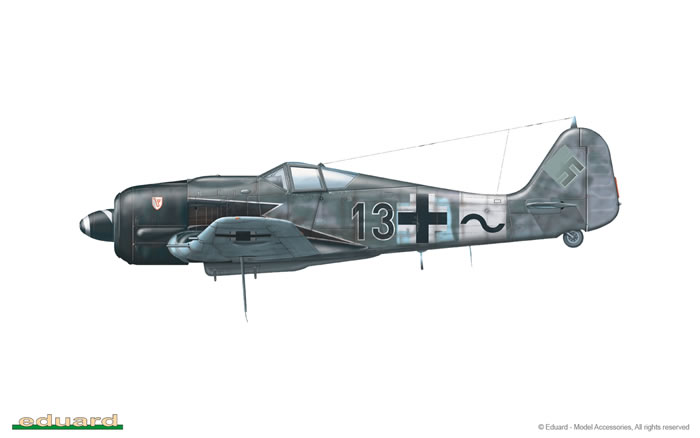
- Option-B, 6/JG 300, Paul Lixfeld, late 1944.
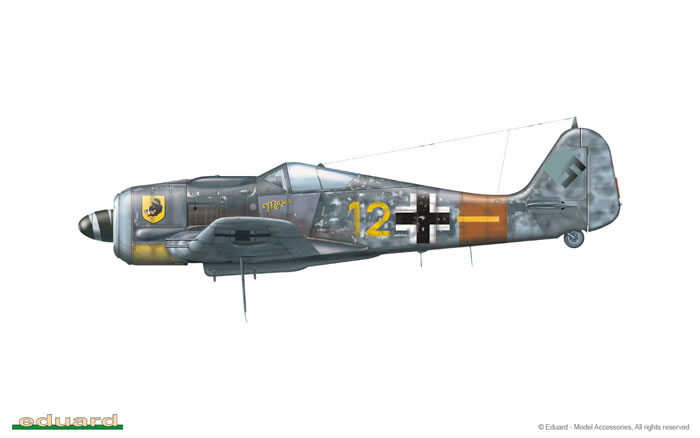
The decals appear to be of excellent quality. swastikas are provided as two-part decals on all sheets, with complete swastikas included in a corner that can be cut off for markets that do not permit its display.
Eduard’s Fw 190A-8 is the best in 1/72 scale by a long measure. The Weekend Edition is only bettered by the same brand’s Profipack Edition with its colour PE details and paint mask. This is Eduard’s second Fw 190A-8 Weekend Edition, which offers two quite differently configured aircraft to the earlier one.
Not everyone likes PE; and for these people, or those building a closed canopy model where the PE extras will be far less noticeable, the Weekend Edition makes perfect sense and is great value. It is also a great choice for anyone contemplating using the superb Brassin resin cockpit set, because there is little point in paying a premium for the Profipack Edition’s coloured PE if is not to be used.
Hasegawa’s Fw 190 kits were arguably the best in 1/72 scale for the past 24 years. Eduard’s new kits are superb examples of the 1/72 kit maker’s art; only time will tell if they will remain the best until 2039, but they seemingly have every chance of doing so for now.
I cannot recommend this kit highly enough.
Thanks to Eduard for the sample
Review Text Copyright © 2016 by Mark Davies
Page Created 30 June, 2016
Last updated
30 June, 2016
Back to HyperScale Main Page
Back to Reviews Page |
